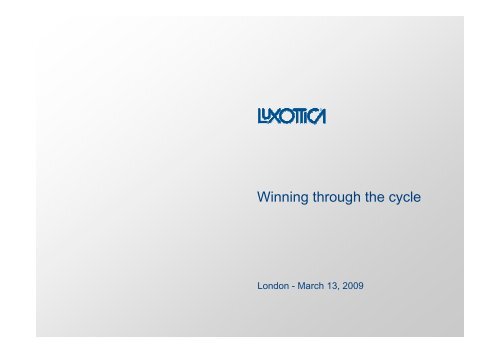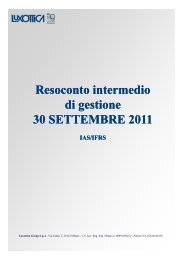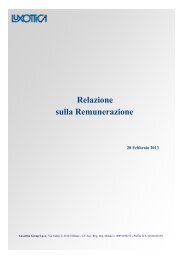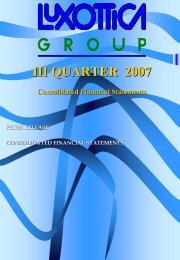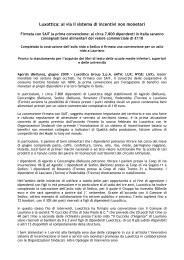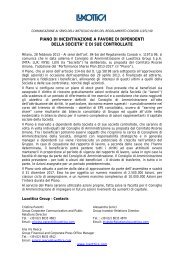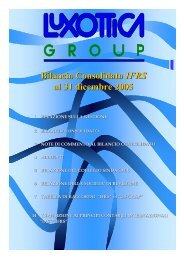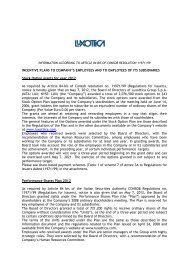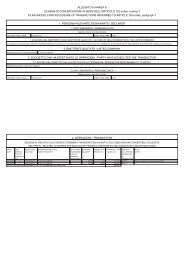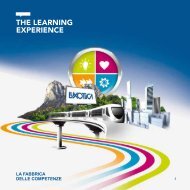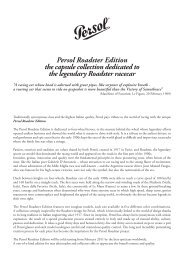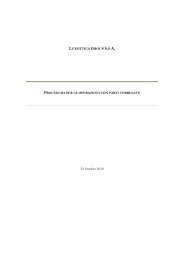703 KB - Luxottica
703 KB - Luxottica
703 KB - Luxottica
You also want an ePaper? Increase the reach of your titles
YUMPU automatically turns print PDFs into web optimized ePapers that Google loves.
Winning through the cycle<br />
London - March 13, 2009<br />
Winning through the cycle
Forward looking statements<br />
Certain statements in this investor presentation may constitute “forward-looking statements” as defined in the<br />
Private Securities Litigation Reform Act of 1995. Such statements involve risks, uncertainties and other factors that<br />
could cause actual results to differ materially from those that are anticipated. Such risks and uncertainties include,<br />
but are not limited to, the ability to successfully integrate Oakley’s operations, the ability to realize expected<br />
synergies from the merger with Oakley, the ability to successfully introduce and market new products, the ability to<br />
maintain an efficient distribution network, the ability to predict future economic conditions and changes in<br />
consumer preferences, the ability to achieve and manage growth, the ability to negotiate and maintain favorable<br />
license arrangements, the availability of correction alternatives to prescription eyeglasses, fluctuations in exchange<br />
rates, the ability to effectively integrate other recently acquired businesses, as well as other political, economic and<br />
technological factors and other risks referred to in <strong>Luxottica</strong> Group’s filings with the US Securities and Exchange<br />
Commission.<br />
Although <strong>Luxottica</strong> Group believes its expectations are based on reasonable assumptions, it cannot assure the<br />
expectations reflected herein will be achieved. This forward-looking information may prove to be inaccurate and<br />
actual results may differ significantly from those anticipated if one or more of the underlying assumptions or<br />
expectations proves to be inaccurate or is unrealized or if other unexpected conditions or events occur.<br />
These forward-looking statements are made as of the date hereof and, under US securities regulation, <strong>Luxottica</strong><br />
Group undertakes no obligation to subsequently update or revise the forward-looking statements made in this<br />
presentation to reflect events or circumstances after the date of this presentation.<br />
Winning through the cycle<br />
2
Summary<br />
Group results for FY 2008<br />
2008 accomplishments<br />
Managing and winning through the cycle<br />
Conclusion<br />
Appendix<br />
Winning through the cycle<br />
3
FY 2008<br />
Group results &<br />
accomplishments<br />
Winning through the cycle
FY 2008: overview<br />
A year of integration within an increasingly tough macroeconomic environment<br />
Consolidated sales at an all-time high of €5.2 billion, up Y-o-Y by 4.7%<br />
Up by 10.7% at constant exchange rates<br />
Net income at €395 million<br />
Not including the write-off of credit related to the sale of the Things Remembered business<br />
Dilution of operating margin by 110 bps<br />
Wholesale margin at 22.1%, from pro forma (1) operating margin of 23% for 2007<br />
Retail margin at 9.4%, from pro forma (1) operating margin of 11.1% for 2007<br />
Yet another year of solid free cash flow (3) generation<br />
€302 million of free cash flow (3)<br />
Good control of working capital<br />
Continued investment in long-term projects: nearly €300 million of Capex in addition to the<br />
one-off charges related to the merger with Oakley<br />
Net Debt to EBITDA ratio (2)(3) of 2.9x (2.8x excluding the impact of exchange rate fluctuations)<br />
Adjusting our business for the tough macroeconomic environment<br />
(1) Pro forma data reflects the inclusion of the consolidated results of Oakley, Inc., a subsidiary that was acquired in November 2007, as if it was acquired on January 1, 2007<br />
(2) In the Net debt/EBITDA ratio, EBITDA is calculated for the 12 months ending on the respective date<br />
(3) Free cash flow, EBITDA, Net debt and Net debt/EBITDA are not US GAAP measures. For additional disclosure regarding non-US GAAP measures and a reconciliation to<br />
US GAAP measures, see Appendix.<br />
Winning through the cycle<br />
5
4Q08: overview<br />
Market conditions deteriorated in the final two months of the quarter<br />
Consolidated sales at €1.2 billion, up by 4%<br />
Flat at constant exchange rates<br />
Dilution of operating margin by 250 bps<br />
Wholesale margin at 17.2%, from pro forma (1) operating margin of 20.3% for 4Q07<br />
Retail margin at 5.5%, from pro forma (1) operating margin of 7.7% for 4Q07<br />
Free cash flow (2) for the quarter of €18 million, compared with €44 million negative cash flow<br />
for 4Q07<br />
Good control of working capital<br />
Production readjusted in 4Q08 to realign inventory levels with demand<br />
The organization moved into action immediately,<br />
results to be realized over the coming quarters<br />
(1) Pro forma data reflects the inclusion of the consolidated results of Oakley, Inc., a subsidiary that was acquired in November 2007, as if it was acquired on January 1, 2007<br />
(2) Free cash flow is not a US GAAP measure. For additional disclosure regarding non-US GAAP measures and a reconciliation to US GAAP measures, see Appendix.<br />
Winning through the cycle<br />
6
FY 2008: consolidated results<br />
FY08<br />
FY08<br />
4Q08<br />
4Q08<br />
€ million<br />
vs. FY07 (1)<br />
€ million<br />
vs. 4Q07<br />
Net sales<br />
reported at current exchange rates<br />
pro forma (2) at constant exchange rates<br />
EBITDA<br />
Y-o-Y margin (3) change vs. pro forma (2)<br />
Operating income<br />
Y-o-Y margin change vs. pro forma (2)<br />
Net income (4)<br />
in €<br />
EPS before trademark amortization (4) (5)<br />
in €<br />
in US$<br />
EPS reported (4)<br />
in €<br />
in US$<br />
5,201.6<br />
1,014.7<br />
749.8<br />
395.0<br />
0.96<br />
1.42<br />
0.87<br />
1.27<br />
+4.7%<br />
-0.8%<br />
-120 bps<br />
-110 bps<br />
-17.6%<br />
-15.4%<br />
-9.2%<br />
-17.8%<br />
-11.8%<br />
1,236.5<br />
186.1<br />
117.4<br />
54.1<br />
0.14<br />
0.19<br />
0.12<br />
0.16<br />
+4.0%<br />
-5.5%<br />
-280 bps<br />
-250 bps<br />
-44.2%<br />
-39.7%<br />
-45.1%<br />
-44.3%<br />
-49.3%<br />
(1) Excluding non-recurring gain related to the sale of a real estate property in 2Q07. The impact of the sale was a gain of approximately €20 million before taxes and approximately €13<br />
million after taxes, equivalent to €0.03 at EPS level.<br />
(2) Pro forma data reflects the inclusion of the consolidated results of Oakley, Inc., a subsidiary that was acquired in November 2007, as if it was acquired on January 1, 2007<br />
(3) EBITDA and EBITDA margin are not US GAAP measures. For additional disclosure regarding non-US GAAP measures and a reconciliation to US GAAP measures, see Appendix.<br />
(4) Excluding the write-off of credit related to the sale of the Things Remembered business<br />
(5) EPS before trademark amortization is not a US GAAP measure. For additional disclosure regarding non-US GAAP measures and a reconciliation to US GAAP measures, see<br />
Appendix.<br />
Winning through the cycle<br />
7
FY 2008: debt overview<br />
Millions of Euro<br />
Dec. 31,<br />
2008<br />
Dec.31,<br />
2007<br />
Dec. 31,<br />
2008<br />
∆<br />
EBITDA (1) 1,015<br />
∆ working capital (77)<br />
Capex (296)<br />
Operating cash flow 641<br />
Financial charges (3) (122)<br />
Taxes (202)<br />
Extraordinary charges (4) (15)<br />
Free cash flow (1) 302<br />
Net debt (1) (US$) (3,058) (2,881) +176<br />
Net debt (1) (€) (825) (895) (70)<br />
Translation adj. (103)<br />
€ 1 = US$ 1.4603 1.3919<br />
Net debt (1) (€) (2,872) (2,950) (78)<br />
Net debt/EBITDA (1) 2.7x 2.9x<br />
Net debt/EBITDA (1) (2)<br />
excluding exchange 2.8x 2.8x<br />
rate effect<br />
(1) Free cash flow, EBITDA, Net debt and Net debt/EBITDA are not US GAAP measures. For additional disclosure regarding non-US GAAP measures and a reconciliation<br />
to US GAAP measures, see Appendix.<br />
(2) The ratio is calculated translating the Net debt and EBITDA at the average exchange rate of 2008 and the average exchange rate of 2007, respectively<br />
(3) Equals interest income minus interest expenses<br />
(4) Equals extraordinary income minus extraordinary expenses<br />
Winning through the cycle<br />
8
FY 2008: plenty of accomplishments<br />
Clarity of vision, cultural changes<br />
The addition of Oakley<br />
The brand proved to be highly resilient even as the economy slowed<br />
All activities planned for the first year of integration now fully completed<br />
Ray-Ban enjoyed its sixth year in a row of double-digit sales growth<br />
Great volumes, success of Rx products and better mix<br />
Iconic styles continue to be highly successful<br />
Developed a solid and well-balanced presence in emerging markets<br />
Demonstrated dynamism toward a changing environment<br />
2Q08: North American retail cost structure readjusted<br />
3Q08 & 4Q08: solid work around working capital optimization<br />
Enhanced planning and allocation processes<br />
Faster-moving and more cost-efficient structure<br />
Winning through the cycle<br />
9
FY 2008: Oakley results<br />
Continued to build the brand around the world through sports marketing,<br />
events and training<br />
Beijing Summer Olympics<br />
Expansion of rolling O lab training program<br />
Delivered results in line with plan<br />
Sales up by 15% in US$<br />
Led by North America and Asia-Pacific regions<br />
Strong performance within LensCrafters and Sunglass Hut<br />
Took actions to reduce costs and risk as the environment became more<br />
challenging in 4Q08<br />
Drove growth through key initiatives<br />
Sport Performance<br />
Polarized<br />
Women’s<br />
Custom<br />
Completed Wave One New Journey projects and began Wave Two projects<br />
10
FY 2008: accomplishments of the New Journey<br />
Projects in line with plan, reached objectives for 2008<br />
Sharing of information and know-how<br />
Quickly reached initial cost savings<br />
Currently working towards the blueprint for IT<br />
Supply chain opportunities underway<br />
Reorganization in Europe and emerging markets<br />
Set up Oakley HQ in Zurich<br />
Segmentation by channel<br />
Focused on achieving the right positioning for the brand; training retailers<br />
Commercial policy and sales approach appropriate for the brand<br />
Successful first-stage optimization of Oakley’s presence within <strong>Luxottica</strong> stores in North<br />
America<br />
Merchandising and polarization<br />
Rx collection and Oakley authentic lenses in LensCrafters<br />
Sun lenses:<br />
Exchange of know-how, training on technologies, joint development on new projects<br />
REVO launch is underway<br />
Winning through the cycle 11
Managing and winning<br />
through the cycle<br />
Winning through the cycle
A structural reset of the market is currently underway<br />
In recent years, we experienced a mix of real growth and market euphoria and our business<br />
thrived<br />
Wholesale sales CAGR 2003-2008: +21%; organic +12%<br />
Consolidated sales up by over 80% over the past six years<br />
Reshaped and upgraded brand portfolio<br />
Established a strong presence in emerging markets<br />
Demonstrated the ability to quickly reshape organization, infrastructure and costs<br />
What are we seeing today in our industry?<br />
Not a temporary crisis<br />
Not a drastic and definitive collapse<br />
But a global structural reset of the relevant market, resulting in a resizing by approx. 10%<br />
We believe the industry long-term growth drivers have not changed<br />
Working hard to tackle these changes to emerge stronger<br />
and better positioned for the future<br />
Winning through the cycle<br />
13
A winning business model that<br />
will continue to help us win going forward<br />
Distinctive<br />
business model<br />
Vertical integration<br />
Global reach<br />
Strong brand portfolio<br />
Growth DNA<br />
Ability to combine and manage:<br />
Organic growth<br />
External growth<br />
Enhanced adaptability<br />
and flexibility<br />
Adaptability<br />
During the “boom years” we built capacity; now we are<br />
resizing our structure<br />
Flexibility<br />
Already demonstrated in early 2008 the ability to react<br />
quickly<br />
Already controlling working capital in 4Q08 and 1Q09, as<br />
anticipated<br />
Winning through the cycle<br />
14
Managing and winning through the cycle<br />
by acting quickly and decisively on five key pillars<br />
Aspiration<br />
Sustained<br />
growth<br />
Backbone<br />
Strong<br />
balance<br />
sheet<br />
Flexible<br />
cost<br />
structure<br />
Adaptive<br />
commercial<br />
approach<br />
Asset<br />
Winning organization mindset and systems<br />
Winning through the cycle<br />
15
A key pillar: sustained growth<br />
Growth is in our DNA<br />
Always balance organic growth with external growth<br />
In 2009:<br />
Organic growth: challenging<br />
External growth: closely monitoring selective opportunities in emerging markets<br />
Taking no shortcuts<br />
Winning through the cycle<br />
16
A key pillar: sustained growth<br />
Brand portfolio management<br />
Ray-Ban: expecting further growth<br />
Continuing to expand the collection, improving the product mix<br />
Great success of iconic styles<br />
Boosting Rx<br />
Oakley: another positive year of growth<br />
Leveraging the uniqueness of brand positioning<br />
Year two of the benefits deriving from the reorganization in Europe and emerging<br />
markets<br />
Continued focus on Rx, O Custom, polarized<br />
Great new product releases<br />
Prescription vs. sun, optimizing collections<br />
Rx launch of Prada Linea Rossa, Arnette and Ralph<br />
Fewer but significantly edgier styles<br />
Anticipated by 45 days the launch of the new optical collections<br />
Luxury & premium<br />
More projects, more focus, more innovation<br />
Reducing entry prices by 10%<br />
Still a key long-term opportunity<br />
Winning through the cycle<br />
17
A key pillar: sustained growth<br />
Wholesale: a highly adaptive commercial approach<br />
Well-balanced global presence expected to be a key advantage<br />
Revolutionizing how we approach the top 30% of our clients<br />
brand by brand<br />
sell in<br />
single merchandising activities<br />
standardized commercial terms<br />
portfolio approach<br />
sell out<br />
plan of activities for the full year<br />
investing in their growth<br />
Improving margins for our top clients on more resilient Rx products to spur growth<br />
Further segmentation of client base on service and commercial conditions<br />
The STARS affiliation program<br />
A strategic growth opportunity<br />
Building on a track record of three years of success<br />
Targeting 1,000 clients<br />
Winning through the cycle<br />
18
Forever Ray-Ban: continuing the reinvention<br />
Heritage and authenticity<br />
Following Wayfarer’s success in 2008, Aviator, Cats,<br />
Clubmaster, Outdoorsman and Wayfarer are now<br />
available in more new colors. Why reinvent? To<br />
constantly be the most iconic brand.<br />
RAY-BAN CLUBMASTER REMASTERS reinventing<br />
the icon in 2009. The 2009 edition reproduces the<br />
original version, adding 8 new colors and patterns in<br />
sun and optical.<br />
Clubmaster: unique, recognizable, inspiring new 50s<br />
trends<br />
Remaster PR events<br />
Partnership with 8 hot, talented music bands<br />
remastering original songs from the fifties and<br />
performing live in 3 key launch events in NY, Beijing<br />
and Milan<br />
AN EXPLOSION OF COLORS<br />
19
Forever Ray-Ban: introducing Ray-Ban Tech<br />
Quality and function: the key values for consumers<br />
focused on performance, high comfort and technology<br />
New Ray-Ban Tech: a carbon fiber collection<br />
Four new styles with state-of-the-art technology<br />
and materials<br />
Breakthrough materials<br />
>Carbon fiber temple<br />
Radical innovation in frame and lens<br />
>Monoblock hinge<br />
20
Oakley: the platform for growth<br />
2009 Actions: continuing to build on successful market and brand initiatives<br />
Leverage strong 2009 product line-up<br />
Sport performance: anchored by Jawbone<br />
Women’s fit fixed in collaboration with <strong>Luxottica</strong> experts<br />
Custom program expanded internationally<br />
Oakley styling and technical details brought front and center in Rx<br />
Segmented, flexible marketing spending: to move closer to the consumer<br />
Focus on owned events and training<br />
Focus on front-line sales associates with the launch of back-end retail support portal Omatter.com<br />
Focus on market segments less sensitive to consumer retail/discretionary spending patterns<br />
True sport performance product, team sales, military and Rx<br />
Enhance the Oakley.com online channel to increase penetration in international markets<br />
Continue to build on Wave One integration effort:<br />
Europe, emerging markets, travel retail, <strong>Luxottica</strong> retail<br />
Manage costs conservatively with inventory to lower than targeted growth rates; slowing down<br />
on new initiatives but moving faster on proven ones<br />
21
Oakley: the growth drivers<br />
A Global Brand yet to be developed<br />
Europe: one of the largest markets in the world. Outside the UK, where Oakley<br />
has built a strong position, the brand is under-represented in almost every market<br />
Rx - initial stage: while for most brands Rx represents at least 35%-40% of units<br />
sold versus sunglass sales, Oakley is still far from it<br />
Women: Oakley entered the women’s business only two years ago. Women<br />
account for 70 to 80% of all eyewear purchases.<br />
Emerging markets: the Oakley brand is known internationally but has not yet<br />
been distributed in some of the largest markets<br />
Superior lens technology: an Oakley key driver since the beginning, now<br />
<strong>Luxottica</strong> retail associates and wholesale partners are helping to pass on this<br />
message<br />
22
Oakley: Jawbone<br />
US Retail: US$195 - US$255<br />
Release: May 2009<br />
Switchlock interchangable lens<br />
technology allows for fast, secure<br />
lens replacement<br />
Distortion free lenses via Oakley’s<br />
cushioned lens suspension system<br />
9 SKUs including HD Polarized<br />
and Photochromic lens options<br />
(additional set of Plutonite lenses<br />
and protective case included<br />
23
The New Journey: Wave Two<br />
Already working on Wave Two projects<br />
Icon Sports Division<br />
Relaunch of REVO<br />
Distribution in 2009 of REVO, Arnette, Fox and Ray-Ban sport collection in US sports<br />
channel<br />
Sun lenses<br />
During 2009, insourcing of relevant product will be almost completed<br />
Emerging markets, especially India and China<br />
Start-up in January 2009<br />
Take advantage of respective capabilities in UK and Brazil<br />
Global supply chain and IT optimization<br />
Oliver Peoples<br />
Winning through the cycle<br />
24
Optical Retail in North America<br />
New optical leadership structure focused on five key priorities<br />
Retail brands<br />
Adjusting messages and offering to “new economy” customers<br />
Higher consistency of in-store service and customers’ experience<br />
Managed Vision Care<br />
More new contracts and strong organic growth with strategic partners<br />
Selective participation in other providers’ panels – opening our stores to more patients<br />
Lenses and manufacturing, leveraging capabilities and partnership<br />
Digital surfacing: still in year one of launch, huge upside<br />
Transitions brand lenses: in-store one hour capability at LensCrafters<br />
Enhancing Rx sun for wrap styles – including Oakley authentics<br />
Ray-Ban Rx lens will be launched soon in all retail stores<br />
Cost structure<br />
Continuing strong push for further efficiencies (rent, sourcing and waste reduction)<br />
Category: educate on the importance of eye health and vision wellness<br />
Partnering with industry to increase category demand<br />
Winning through the cycle<br />
25
Optical Retail in North America<br />
More segmented and differentiated approach on each brand<br />
LensCrafters: returning to historic heart and soul of the brand<br />
Service!<br />
Lenses!<br />
Entry to premium, value for all budgets<br />
Pearle Vision: riding the eyecare/insurance wave<br />
Insured customers using their benefits more than ever<br />
Corporate and franchise doctors well positioned<br />
Sears: “Exceptional Value” positioning bearing fruits<br />
Package pricing, easy to sell and better appreciated by customers<br />
Reintroducing warranty sales, a value for Sears customers<br />
Target: simple, fun and stylish (the “anti-optical”)<br />
Leveraging on growth of previous years<br />
Expanding sun as major focus<br />
Winning through the cycle<br />
26
Sunglass Hut: a global opportunity<br />
Now a truly global brand<br />
Challenging environment in North America but positive performance in the rest of the world<br />
After 18-month rollout, new store design proved to be a winning asset<br />
North America in 2009:<br />
Attracting new customers, focusing on younger generation<br />
Boosting exclusive programs<br />
Deeper and more integrated brand stories in the stores<br />
AUR improvement driven by<br />
> Polarized lenses<br />
> Exclusive collections and brands<br />
Leveraging www.sunglasshut.com e-commerce platform<br />
Only six months old, huge upside potential<br />
Drive new premium customers<br />
> The objective is to exceed 1% of total Sunglass Hut sales in 2009<br />
Global expansion, where next?<br />
Closely monitoring a number of opportunities<br />
Winning through the cycle<br />
27
A key pillar: a strong balance sheet<br />
Working capital optimization<br />
10% - 15% inventory reduction<br />
Resized workforce across operations<br />
Adopted temporary, government-subsidized leave in Italy (Cassa Integrazione<br />
Guadagni)<br />
New organization in place for centralized inventory management, excluding Oakley<br />
Moving strategic suppliers to consignment stock<br />
Improving factories’ through-put days (15% improvement from 2008)<br />
> Decreasing WIP offers even more flexibility<br />
Receivables: flat, in days<br />
Great achievements over the past four years (-30 days vs. 2004)<br />
Strict control on a weekly basis across all geographic regions<br />
Flexible approach to key clients<br />
Over 30 days overdue account for approx. 5% of the days outstanding<br />
Payables: +5 days<br />
Already renegotiated terms with 80% of suppliers<br />
Winning through the cycle<br />
28
A key pillar: a strong balance sheet<br />
Capex<br />
Spending less than €200 million in 2009<br />
Down more than 30% vs. 2008 (€300 million)<br />
Continued significant investments in IT (€50 million) to create greater efficiencies within the<br />
New Group<br />
Creating a unified supply chain for the Group<br />
> Reducing DC’s by 12 by 2011<br />
Building up shared service centers across the organization<br />
Reviewing global store blueprint<br />
Closings: 117 in NA, additional 110 under review and negotiation<br />
Opening very selective locations: 60 in NA; 20 Oakley; 20 in Asia-Pacific<br />
Rapidly adapting the business model to capture new opportunities<br />
Winning through the cycle<br />
29
A key pillar: a flexible cost structure<br />
Rationale<br />
Cutting only where it generates a return: efficiency is the key driver<br />
After so many years of growth, there is room for further efficiency, BUT it’s painful<br />
Goal: actions to be implemented by June 2009<br />
What if the environment deteriorates further?<br />
Reduce advertising spending if needed, action plan is ready<br />
Structural changes in overall operational blueprint possible<br />
> Factories, warehouses, labs and DC’s<br />
Together with IT investments, cost structure optimization<br />
will make <strong>Luxottica</strong> stronger<br />
Winning through the cycle<br />
30
A key pillar: a flexible cost structure<br />
Wholesale<br />
Brand management<br />
Reducing styles as well as samples<br />
Optimizing the presence of each brand among channels and geographic regions<br />
Eliminating three low-performing brands<br />
New commercial organization already in place<br />
70% of staff on variable packages<br />
Revolutionized approach to top 30% of clients<br />
Reorganized geographic regions and brand approach<br />
Advertising spending<br />
Reduced by 10%, after four years of continuous brand build-up<br />
More activities on the ground and in the stores<br />
> More training, product placements and PR activities<br />
> More attention to in-store product display (where customers make decisions)<br />
G&A<br />
Back office reorganization<br />
Big push for extranet web-based ordering<br />
Return policy and spare parts management revised<br />
> Easier for clients, faster supply chain, better service segmentation<br />
Identified efficiencies of almost €30 million<br />
Winning through the cycle<br />
31
A key pillar: a flexible cost structure<br />
Operations and supply chain<br />
Manufacturing<br />
Working hard to further improve efficiency<br />
Today a much leaner organization: resized workforce across operations<br />
Continuously readapting cost structure (e.g. efficiencies, waste, scrap, utilities, etc.)<br />
Easier negotiations with longer-term agreements for purchases of commodities<br />
Increasing sun lenses insourcing<br />
Supply chain<br />
Negotiated lower transportation fees<br />
Streamlining activities between:<br />
Italy & North America<br />
China & North America<br />
Gaining benefits after the merger with Oakley across the European, Latin American and<br />
Australian organizations<br />
Offsetting nearly 75% of the fixed costs dilution<br />
related to the planned 15% reduction in volumes manufactured<br />
Winning through the cycle<br />
32
A key pillar: a flexible cost structure<br />
Store blueprint<br />
· Stores impacted One-time 2009 Full Year<br />
charges O.I. benefit O.I. benefit<br />
Closings 117 US$4.9 mln US$3.5 mln US$9.4 mln<br />
Franchise conversion 56 US$6.8 mln US$1.7 mln US$6.6 mln<br />
Under review 110 n.a. n.a. n.a.<br />
Occupancy<br />
Comprehensive rationalization of entire store portfolio in process<br />
Negotiation with landlord and impact of co-tenancy lease provisions<br />
Conversion of 56 Pearle Vision stores to franchises to be completed by year end<br />
Lenses and manufacturing<br />
Lens costs, in-source lab work, remake reductions<br />
Other store operating costs<br />
Store maintenance, limit merit increases, utilities, supplies and freight<br />
Advertising spending<br />
10% reduction in 2009<br />
G&A<br />
Vendor consolidation and supplies<br />
Actions already implemented in retail in North America<br />
Winning through the cycle<br />
33
Icon Sports Division<br />
Multi-brand portfolio targeted with expertise in sports and lifestyle segments<br />
Dedicated sales, marketing and brand development team<br />
Leverages Oakley’s expertise and resources to further develop <strong>Luxottica</strong> business in the sport<br />
channel<br />
Provides opportunities for better brand management within our retailers<br />
Winning through the cycle<br />
34
Icon Sports Division<br />
SPORT<br />
FASHION<br />
Sport Specific Active<br />
Lifestyle Fashion Luxury<br />
$350.+<br />
$220-350<br />
$150-220<br />
$90-150<br />
$50-90<br />
$0-50<br />
Winning through the cycle<br />
35
REVO timeline<br />
NASA tens<br />
technology:<br />
Designed for precision<br />
lenses on strategic<br />
defense satellites to<br />
protect against sun’s<br />
rays in outer space.<br />
REVO develops sport<br />
channel:<br />
Strong independent<br />
network of sporting goods<br />
and ski/board shops create<br />
consumer interest<br />
and drive sales.<br />
Icon Sports Division created:<br />
Leveraging Oakley’s sport<br />
category expertise, the Icon<br />
Sports Division begins work on<br />
a completely revamped product<br />
line and brand<br />
1980 1985 ‘85- 90’s 1999<br />
2008<br />
2009<br />
REVO founded:<br />
Mitch Ruda, Engineer,<br />
applies NASA technology<br />
to the first premium price,<br />
sport performance<br />
sunglass<br />
<strong>Luxottica</strong> purchases REVO:<br />
Distribution focused on optical<br />
channel with little penetration in<br />
sport channel. Limited<br />
investments made in the brand.<br />
Relied on brand equity with the<br />
consumer.<br />
New REVO:<br />
Re-newed, Refreshed<br />
and Reinvigorated<br />
brand<br />
and products<br />
launched<br />
Winning through the cycle<br />
36
REVO relaunch: the vision<br />
REVO becomes the most respected and valid choice for polarized lens technology<br />
REVO is known for not having to sacrifice performance and protection for up-to-date style or fashion<br />
REVO is known for product which is designed for the active consumer but is suitable for everyday use<br />
REVO brand identity is one of aspiration and reflects a passion for outdoor pursuits, may it be sports,<br />
adventure travel or protecting the environment<br />
REVO customer and consumer satisfaction is so personal and unique that it becomes a major talking<br />
point about how great the brand is<br />
REVO is very conscious to the world’s ecological challenges and therefore acts in a responsible and<br />
active way<br />
Winning through the cycle<br />
37
REVO relaunch: year one<br />
Position the Brand:<br />
Alignment and endorsement with outdoor influencers that represent both sport and a humanitarian<br />
cause<br />
Invest in a significant PR push aligned with appropriate humanitarian and environmental causes<br />
Invest in key technical training programs which support all key retail distribution plans<br />
Re-launch a completely redesigned website that provides the entire Revo story<br />
Support key trade initiatives through Sunglass Hut front door campaign, revised pop collateral and<br />
tradeshows<br />
Introduce compelling new product:<br />
Reinstate REVO’s polarized lens superiority by introducing light enhancing tints in both glass and<br />
polycarbonate offerings which utilize branded technologies<br />
Launch a new collection of distinctive frames (13 styles) in 4 simplified segments: Nylon, Acetate,<br />
Metal, and RevoFlex<br />
Introduce REVO Re-Use frame components which are made from 100% recycled pre-consumer<br />
polymer resins<br />
Winning through the cycle<br />
38
REVO relaunch: year one<br />
Target distribution, service and sell-through which is vital in building<br />
long term brand foundation<br />
<br />
<br />
<br />
<br />
<br />
Establish authentic recognition in the outdoor sport channel with distribution in influencer sport<br />
independents<br />
Focus on water-based and outdoor sports related retailers in the key regions of West,<br />
Southwest, Rockies, Southeast, Northeast<br />
Sport Key Account strategy is critical to driving revenue and brand integrity<br />
Build brand identity in the sun specialty and 3 O’s channel<br />
Sunglass Hut will provide broad distribution and visibility driving approx. 70% of overall US sales<br />
Sales organization structure will utilize existing <strong>Luxottica</strong> sport brand sales force, now report into<br />
Oakley<br />
Reps will handle REVO, Arnette, Ray Ban (in sports doors only) and Fox (in some cases)<br />
Regional focus<br />
Best-in-class service with training and brand education as primary drivers<br />
Key Account management aligned with Oakley<br />
Winning through the cycle<br />
39
REVO 2009 product line<br />
Metal (4 Styles)<br />
Discern<br />
Efflux<br />
Undercut<br />
Transom<br />
RevoFlex (3 Styles)<br />
Reach<br />
Rise<br />
Plot<br />
Winning through the cycle<br />
40
REVO 2009 product line<br />
Acetate (1 Style)<br />
Headwall<br />
Nylon (5 Styles)<br />
Abyss<br />
Red Point<br />
Thrive<br />
Winning through the cycle<br />
41
REVO brand philosophy and marketing campaign<br />
Most people live somewhere in the middle,<br />
a safe place far away from those moments<br />
of clarity when eyes are open to every<br />
possibility. Leaving the middle ground<br />
takes vision, the kind that lets you see the<br />
polar ends of the spectrum where lifework<br />
and life escape become ultimate.<br />
REVO Sunglasses give you the vision to realize<br />
that limits are where life begins. They let you see<br />
beyond the ordinary and focus on the extremes of<br />
possibility, as far away from the middle as you<br />
can get. This life, eyes wide open.<br />
Escape the middle ground.<br />
Polarize your life<br />
Winning through the cycle<br />
42
Conclusions<br />
Winning through the cycle
The starting point<br />
We do not want to be either overly pessimistic or optimistic<br />
We chose not to provide guidance for 2009 as the current environment is profoundly<br />
uncertain<br />
We are currently working on:<br />
1Q09 inventory reduction: Italian production down by over 20%<br />
1Q09 cost realignment: initial efficiencies underway<br />
Overall very soft business in the first two weeks of January<br />
Wholesale: very challenging comparison with a particularly strong 1Q08<br />
Winning through the cycle<br />
44
A walk through sensitivity for 2009: currency impact<br />
FY08 Actual<br />
€ million<br />
2008 sales<br />
breakdown by<br />
currencies<br />
2008 costs<br />
breakdown by<br />
currencies<br />
Flat sales scenario<br />
(FY08 with 2009<br />
exch. Rates)<br />
€ million<br />
Net Sales: 5,202<br />
Oper.Inc.: 750<br />
Margin 14.4%<br />
JPY 2%<br />
GBP 3%<br />
AUD 8%<br />
Others 9%<br />
€ 19%<br />
AUD 7%<br />
CNY 3%<br />
Others 6%<br />
€ 27%<br />
Net Sales: 5,542<br />
Oper.Inc.: 782<br />
Margin 14.1%<br />
2008 actual<br />
exch. rates<br />
2009 bdg.<br />
exch. rates<br />
∆<br />
vs. 2008<br />
€=US$ 1.47<br />
€=AUD 1.75<br />
€=GBP 0.80<br />
€=CNY 10.22<br />
US$ 59%<br />
US$ 57%<br />
€=US$ 1.30 +13%<br />
€=AUD 2.00 -12%<br />
€=GBP 0.90 -12%<br />
€=CNY 9.25 +10%<br />
Currency impact on sales and costs would be +6.5% and +6.9%, respectively,<br />
leading to 30 bps dilution<br />
Winning through the cycle<br />
45
Sensitivity analysis for 2009<br />
(€=US$ 1.30)<br />
Sales growth scenarios:<br />
Current<br />
exchange rate +6.5% +2.5%/flat -2%/-6%<br />
Constant<br />
exchange rate<br />
0% -4%/-6% -8%/-12%<br />
Operating margin<br />
impact vs. 2008<br />
120 bps<br />
dilution<br />
approx.<br />
320 bps<br />
dilution<br />
approx.<br />
500 bps<br />
dilution<br />
Net Income<br />
vs. 2008 unchanged -15%/-20% -30%/-40%<br />
In one-year time horizon, 50% of total costs remain fixed,<br />
thus leading to approx. 90 bps dilution in a “0% growth scenario”<br />
Winning through the cycle<br />
46
Drawing some conclusions<br />
No change in our long-term strategy<br />
Maintaining a balance between wholesale and retail<br />
Growth platforms are in place and our balance sheet is solid<br />
Even with a very difficult 2009, we are taking actions to readjust costs BUT maintaining the<br />
right investment levels to support our continued leadership worldwide<br />
The uncertainty of the current environment does not put our long-term sustainable growth<br />
at risk<br />
Winning through the cycle<br />
47
OneSight sm , A <strong>Luxottica</strong> Group Foundation<br />
Who we are<br />
Family of charitable programs dedicated to improving vision through outreach, research and<br />
education<br />
Combines 20 years of innovation from three regional programs (Give the Gift of Sight, Pearle<br />
Vision Foundation, Community-I Care) into one global organization<br />
Why we care<br />
Millions of people worldwide suffer from poor vision<br />
As a worldwide leader in this industry, <strong>Luxottica</strong> has the<br />
global reach, expertise and passion to help the world see<br />
What we do<br />
Global Eye Care<br />
• Hand-delivering vision care, eyewear in developing countries<br />
• Over 150 Clinics to 32 developing countries; 3+ million helped<br />
Regional Eye Care<br />
• Regional and Vision Van Clinics across North America, Australia, China<br />
• 35+ weeks of Clinic, 33,000+ helped annually<br />
Community Eye Care<br />
• In-store and outreach programs across North America and Australia<br />
• 240,000+ helped annually<br />
Preventative Eye Care<br />
• €244,000+ granted to support research seeking cures for preventable blindness<br />
• Thousands in scholarships for students seeking degree in Optometry<br />
Winning through the cycle<br />
48
Fare clic per modificare gli stili del testo dello schema<br />
Secondo livello<br />
Terzo livello<br />
>Quarto livello<br />
·Quinto livello<br />
Appendix
Non-US GAAP Measures:<br />
EPS before Trademark Amortization<br />
Earnings per share before trademark amortization: Earnings per share (EPS) before trademark amortization means earnings per share before<br />
trademark and other similar intangible asset amortization expense, net of taxes, per share. The Company believes that EPS before trademark<br />
amortization is useful to both management and investors in evaluating the Company’s operating performance and prospects compared to that of<br />
other companies in its industry. Our calculation of EPS before trademark amortization allows us to compare our earnings per share with those of<br />
other companies without giving effect to the accounting effects of the amortization of the Company’s trademarks and other similar intangible<br />
assets, which may vary for different companies for reasons unrelated to the overall operating performance of a company’s business.<br />
EPS before trademark amortization is not a measure of performance under accounting principles generally accepted in the United States (U.S.<br />
GAAP). We include it in this presentation in order to:<br />
improve transparency for investors;<br />
assist investors in their assessment of the Company’s operating performance;<br />
ensure that this measure is fully understood in light of how the Company evaluates its operating results;<br />
properly define the metrics used and confirm their calculation; and<br />
share this measure with all investors at the same time.<br />
EPS before trademark amortization is not meant to be considered in isolation or as a substitute for items appearing on our financial statements<br />
prepared in accordance with U.S. GAAP. Rather, this non-GAAP measure should be used as a supplement to U.S. GAAP results to assist the<br />
reader in better understanding the operational performance of the Company. The Company cautions that this measure is not a defined term under<br />
U.S. GAAP and its definition should be carefully reviewed and understood by investors. Investors should be aware that <strong>Luxottica</strong> Group’s method<br />
of calculating EPS before trademark amortization may differ from methods used by other companies. The Company recognizes that the<br />
usefulness of EPS before trademark amortization as an evaluative tool may have certain limitations, including:<br />
EPS before trademark amortization does not include the effects of amortization of the Company’s trademarks and other intangible assets.<br />
Because trademarks and other intangible assets are important to our business and to our ability to generate sales, we consider trademark<br />
amortization expense as a necessary element of our costs. Therefore, any measure that excludes trademark amortization expense may have<br />
material limitations.<br />
We compensate for these limitations by using EPS before trademark amortization as one of several comparative tools, together with U.S. GAAP<br />
measurements, to assist in the evaluation of our operating performance.<br />
See the tables on the following pages for a reconciliation of EPS before trademark amortization to EPS, which is the most directly comparable U.S.<br />
GAAP financial measure.<br />
Winning through the cycle<br />
50
Non-US GAAP Measures:<br />
EPS before Trademark Amortization<br />
Millions of Euro, unless otherwise noted<br />
FY08 (2) FY07 (1)<br />
∆<br />
Trademark amortization and other similar intangible assets<br />
(+)<br />
72<br />
64<br />
Taxes on trademark amortization and other similar intangible assets<br />
(-)<br />
(26)<br />
(24)<br />
Trademark amortization and other similar intangible assets, net of taxes<br />
(=)<br />
45<br />
40<br />
Average number of shares outstanding as of December 31 (in thousands)<br />
(/)<br />
456,564<br />
455,185<br />
Trademark amortization and other similar intangible assets, net of taxes,<br />
per share (=)<br />
0.10<br />
0.09<br />
EPS (+)<br />
0.87<br />
1.05<br />
-17.8%<br />
EPS before trademark amortization and other similar intangible assets,<br />
net of taxes (=)<br />
0.96<br />
1.14<br />
-15.4%<br />
€/US$ average exchange rate<br />
1.4707<br />
1.3705<br />
EPS before trademark amortization and other similar intangible assets,<br />
net of taxes (in US$)<br />
1.42<br />
1.56<br />
-9.2%<br />
(1) Excluding non-recurring gain related to the sale of a real estate property in 2Q 2007. The impact of the sale was a gain of approximately €20 million before taxes and<br />
approximately €13 million after taxes, equivalent to €0.03 at EPS level.<br />
(2) Excluding the write-off of credit related to the sale of the Things Remembered business. The impact of such write-off is a loss of approximately €15 million after tax or<br />
€0.03 per share.<br />
Winning through the cycle<br />
51
Non-US GAAP Measures:<br />
EPS before Trademark Amortization<br />
Millions of Euro, unless otherwise noted<br />
4Q08 (1)<br />
4Q07<br />
∆<br />
Trademark amortization and other similar intangible assets<br />
(+)<br />
19<br />
20<br />
Taxes on trademark amortization and other similar intangible assets<br />
(-)<br />
(7)<br />
(8)<br />
Trademark amortization and other similar intangible assets, net of taxes<br />
(=)<br />
12<br />
13<br />
Average number of shares outstanding as of December 31 (in thousands)<br />
(/)<br />
456,816<br />
456,048<br />
Trademark amortization and other similar intangible assets, net of taxes,<br />
per share (=)<br />
0.03<br />
0.03<br />
EPS (+)<br />
0.12<br />
0.21<br />
-44.3%<br />
EPS before trademark amortization and other similar intangible assets,<br />
net of taxes (=)<br />
0.14<br />
0.24<br />
-39.7%<br />
€/US$ average exchange rate<br />
1.3180<br />
1.4486<br />
EPS before trademark amortization and other similar intangible assets,<br />
net of taxes (in US$)<br />
0.19<br />
0.35<br />
-45.1%<br />
(1) Excluding the write-off of credit related to the sale of the Things Remembered business. The impact of such write-off is a loss of approximately €15 million after tax or<br />
€0.03 per share.<br />
Winning through the cycle<br />
52
Non-US GAAP Measures:<br />
EBITDA and EBITDA margin<br />
EBITDA represents operating income before depreciation and amortization. EBITDA margin means EBITDA divided by net sales. The Company<br />
believes that EBITDA is useful to both management and investors in evaluating the Company’s operating performance compared to that of other<br />
companies in its industry. Our calculation of EBITDA allows us to compare our operating results with those of other companies without giving<br />
effect to financing, income taxes and the accounting effects of capital spending, which items may vary for different companies for reasons<br />
unrelated to the overall operating performance of a company’s business.<br />
EBITDA and EBITDA margin are not measures of performance under accounting principles generally accepted in the United States (US GAAP).<br />
We include them in this presentation in order to:<br />
improve transparency for investors;<br />
assist investors in their assessment of the Company’s operating performance and its ability to refinance its debt as it matures and incur<br />
additional indebtedness to invest in new business opportunities;<br />
assist investors in their assessment of the Company’s cost of debt;<br />
ensure that these measures are fully understood in light of how the Company evaluates its operating results and leverage;<br />
properly define the metrics used and confirm their calculation; and<br />
share these measures with all investors at the same time.<br />
EBITDA and EBITDA margin are not meant to be considered in isolation or as a substitute for items appearing on our financial statements<br />
prepared in accordance with US GAAP. Rather, these non-GAAP measures should be used as a supplement to US GAAP results to assist the<br />
reader in better understanding the operational performance of the Company. The Company cautions that these measures are not defined terms<br />
under US GAAP and their definitions should be carefully reviewed and understood by investors. Investors should be aware that <strong>Luxottica</strong> Group’s<br />
method of calculating EBITDA may differ from methods used by other companies. The Company recognizes that the usefulness of EBITDA has<br />
certain limitations, including:<br />
EBITDA does not include interest expense. Because we have borrowed money in order to finance our operations, interest expense is a<br />
necessary element of our costs and ability to generate profits and cash flows. Therefore, any measure that excludes interest expense<br />
may have material limitations;<br />
EBITDA does not include depreciation and amortization expense. Because we use capital assets, depreciation and amortization expense<br />
is a necessary element of our costs and ability to generate profits. Therefore, any measure that excludes depreciation and expense may<br />
have material limitations;<br />
EBITDA does not include provision for income taxes. Because the payment of income taxes is a necessary element of our costs, any<br />
measure that excludes tax expense may have material limitations;<br />
EBITDA does not reflect cash expenditures or future requirements for capital expenditures or contractual commitments;<br />
EBITDA does not reflect changes in, or cash requirements for, working capital needs;<br />
EBITDA does not allow us to analyze the effect of certain recurring and non-recurring items that materially affect our net income or loss.<br />
We compensate for the foregoing limitations by using EBITDA as a comparative tool, together with US GAAP measurements, to assist in the<br />
evaluation of our operating performance and leverage.<br />
See the tables on the following pages for a reconciliation of EBITDA to operating income, which is the most directly comparable US GAAP<br />
financial measure, as well as the calculation of EBITDA margin on net sales.<br />
Winning through the cycle<br />
53
Non-US GAAP Measures:<br />
EBITDA and EBITDA margin<br />
Millions of Euro<br />
4Q08 4Q07 4Q07 pro forma (1)<br />
Operating income (+)<br />
117.4<br />
151.7<br />
150.6<br />
Depreciation & amortization<br />
(+)<br />
68.6<br />
64.0<br />
73.2<br />
EBITDA<br />
(=)<br />
186.1<br />
215.7<br />
223.8<br />
Net sales<br />
(/)<br />
1,236.5<br />
1,188.5<br />
1,257.9<br />
EBITDA margin<br />
(=)<br />
15.0%<br />
18.1%<br />
17.8%<br />
(1) These pro forma figures reflect the inclusion of the consolidated results of Oakley, Inc., a subsidiary that was acquired in November 2007, as if it was acquired on<br />
January 1, 2007<br />
Winning through the cycle<br />
54
Non-US GAAP Measures:<br />
EBITDA and EBITDA margin<br />
Millions of Euro<br />
FY08<br />
FY07 (2)<br />
FY07<br />
pro forma (1)(2)<br />
Operating income (+)<br />
749.8<br />
813.3<br />
858.1<br />
Depreciation & amortization<br />
(+)<br />
264.9<br />
232.8<br />
288.2<br />
EBITDA<br />
(=)<br />
1,014.7<br />
1,046.1<br />
1,146.3<br />
Net sales<br />
(/)<br />
5,201.6<br />
4,966.1<br />
5,539.0<br />
EBITDA margin<br />
(=)<br />
19.5%<br />
21.1%<br />
20.7%<br />
(1) These pro forma figures reflect the inclusion of the consolidated results of Oakley, Inc., a subsidiary that was acquired in November 2007, as if it was acquired on<br />
January 1, 2007<br />
(2) Excluding non-recurring gain related to the sale of a real estate property in 2Q 2007. The impact of the sale was a gain of approximately €20 million before taxes and<br />
approximately €13 million after taxes, equivalent to €0.03 at EPS level.<br />
Winning through the cycle<br />
55
Non-US GAAP Measures:<br />
Net Debt to EBITDA ratio<br />
Net debt to EBITDA ratio: Net debt means the sum of bank overdrafts, current portion of long-term debt and long-term debt, less cash. EBITDA<br />
represents operating income before depreciation and amortization. The Company believes that EBITDA is useful to both management and investors in<br />
evaluating the Company’s operating performance compared to that of other companies in its industry. Our calculation of EBITDA allows us to compare our<br />
operating results with those of other companies without giving effect to financing, income taxes and the accounting effects of capital spending, which items<br />
may vary for different companies for reasons unrelated to the overall operating performance of a company’s business. The ratio of net debt to EBITDA is a<br />
measure used by management to assess the Company’s level of leverage, which affects our ability to refinance our debt as it matures and incur additional<br />
indebtedness to invest in new business opportunities. The ratio also allows management to assess the cost of existing debt since it affects the interest rates<br />
charged by the Company’s lenders.<br />
EBITDA and the ratio of net debt to EBITDA are not measures of performance under accounting principles generally accepted in the United States (US GAAP).<br />
We include them in this presentation in order to:<br />
improve transparency for investors;<br />
assist investors in their assessment of the Company’s operating performance and its ability to refinance its debt as it matures and incur additional<br />
indebtedness to invest in new business opportunities;<br />
assist investors in their assessment of the Company’s cost of debt;<br />
ensure that these measures are fully understood in light of how the Company evaluates its operating results and leverage;<br />
properly define the metrics used and confirm their calculation; and<br />
share these measures with all investors at the same time.<br />
EBITDA and the ratio of net debt to EBITDA are not meant to be considered in isolation or as a substitute for items appearing on our financial statements<br />
prepared in accordance with US GAAP. Rather, these non-GAAP measures should be used as a supplement to US GAAP results to assist the reader in better<br />
understanding the operational performance of the Company. The Company cautions that these measures are not defined terms under US GAAP and their<br />
definitions should be carefully reviewed and understood by investors. Investors should be aware that <strong>Luxottica</strong> Group’s method of calculating EBITDA and the<br />
ratio of net debt to EBITDA may differ from methods used by other companies. The Company recognizes that the usefulness of EBITDA and the ratio of net debt<br />
to EBITDA as evaluative tools may have certain limitations, including:<br />
EBITDA does not include interest expense. Because we have borrowed money in order to finance our operations, interest expense is a necessary element of<br />
our costs and ability to generate profits and cash flows. Therefore, any measure that excludes interest expense may have material limitations;<br />
EBITDA does not include depreciation and amortization expense. Because we use capital assets, depreciation and amortization expense is a necessary<br />
element of our costs and ability to generate profits. Therefore, any measure that excludes depreciation and expense may have material limitations;<br />
EBITDA does not include provision for income taxes. Because the payment of income taxes is a necessary element of our costs, any measure that excludes<br />
tax expense may have material limitations;<br />
EBITDA does not reflect cash expenditures or future requirements for capital expenditures or contractual commitments;<br />
EBITDA does not reflect changes in, or cash requirements for, working capital needs;<br />
EBITDA does not allow us to analyze the effect of certain recurring and non-recurring items that materially affect our net income or loss; and<br />
The ratio of net debt to EBITDA is net of cash and cash equivalents, restricted cash and short-term investments, thereby reducing our debt position. Because<br />
we may not be able to use our cash to reduce our debt on a dollar-for-dollar basis, this measure may have material limitations.<br />
We compensate for the foregoing limitations by using EBITDA and the ratio of net debt to EBITDA as two of several comparative tools, together with US GAAP<br />
measurements, to assist in the evaluation of our operating performance and leverage.<br />
See the tables on the following pages for a reconciliation of net debt to long-term debt, which is the most directly comparable US GAAP financial measure, as well<br />
as the calculation of the ratio of net debt to EBITDA. For a reconciliation of EBITDA to operating income, which is the most directly comparable US GAAP<br />
financial measure, see the tables on the preceding pages.<br />
Winning through the cycle<br />
56
Non-US GAAP Measures:<br />
Net debt and net debt/EBITDA<br />
Millions of Euro<br />
Dec. 31, 2008 Dec. 31, 2007<br />
Long-term debt<br />
(+)<br />
Current portion of long-term debt<br />
(+)<br />
Bank overdrafts<br />
(+)<br />
Cash<br />
(-)<br />
Net debt<br />
(=)<br />
EBITDA<br />
2,519.3 1,926.5<br />
286.2 792.6<br />
432.5 455.6<br />
(288.5) (302.9)<br />
2,949.5 2,871.8<br />
1,014.7 1,066.1<br />
Net debt/EBITDA<br />
2.9x 2.7x<br />
Net debt @ avg. exchange rates (1)<br />
Net debt (1) /EBITDA<br />
2,821.2 3,010.3<br />
2.8x 2.8x<br />
(1) Calculated using the 12-month average exchange rate as of December 31, 2008 and December 31, 2007, respectively<br />
Winning through the cycle<br />
57
Non-US GAAP Measures:<br />
Free Cash Flow<br />
Free cash flow represents income from operations before depreciation and amortization (i.e. EBITDA, see appendix on page 56), plus or minus<br />
the decrease/(increase) in working capital over the prior period, less capital expenditures, plus or minus interest income/(expense) and net<br />
charges for extraordinary items, minus taxes paid. The Company believes that free cash flow is useful to both management and investors in<br />
evaluating the Company’s operating performance compared to other companies in its industry. In particular, our calculation of free cash flow<br />
provides a clearer picture of the Company’s ability to generate net cash from operations, which may be used, among other things, to fund<br />
discretionary investments, pay dividends or pursue other strategic opportunities.<br />
Free cash flow is not a measure of performance under accounting principles generally accepted in the United States (US GAAP). We include it<br />
in this presentation in order to:<br />
• Improve transparency for investors;<br />
• Assist investors in their assessment of the Company’s operating performance and its ability to generate cash from operations in excess of its<br />
cash expenses;<br />
• Ensure that this measure is fully understood in light of how the Company evaluates its operating results;<br />
• Properly define the metrics used and confirm their calculation; and<br />
• Share this measure with all investors at the same time.<br />
Free cash flow is not meant to be considered in isolation or as a substitute for items appearing on our financial statements prepared in<br />
accordance with US GAAP. Rather, this non-GAAP measure should be used as a supplement to US GAAP results to assist the reader in better<br />
understanding the operational performance of the Company. The Company cautions that this measure is not a defined term under US GAAP<br />
and its definition should be carefully reviewed and understood by investors. Investors should be aware that <strong>Luxottica</strong> Group’s method of<br />
calculation of free cash flow may differ from methods used by other companies. The Company recognizes that the usefulness of free cash flow<br />
as an evaluative tool may have certain limitations, including:<br />
• The manner in which the Company calculates free cash flow may differ from that of other companies, which limits its usefulness as a<br />
comparative measure;<br />
• Free cash flow does not represent the total increase or decrease in the net debt balance for the period since it excludes, among other things,<br />
cash used for funding discretionary investments and to pursue strategic opportunities during the period and any impact of the exchange rate<br />
changes; and<br />
• Free cash flow can be subject to adjustment at the Company’s discretion if the Company takes steps or adopts policies that increase or<br />
diminish its current liabilities and/or changes to working capital.<br />
We compensate for the foregoing limitations by using free cash flow as one of several comparative tools, together with US GAAP<br />
measurements, to assist in the evaluation of our operating performance.<br />
See tables on page 8 and page 56 for a reconciliation of free cash flow to EBITDA and EBITDA to income from operations, respectively, which<br />
is the most directly comparable US GAAP financial measure.<br />
Winning through the cycle<br />
58
Investor Relations team<br />
Alessandra Senici<br />
Tel. +39 (02) 8633 – 4662<br />
alessandra.senici@luxottica.com<br />
Nicoletta Russo<br />
Tel. +39 (02) 8633 – 4718<br />
nicoletta.russo@luxottica.com<br />
www.luxottica.com


